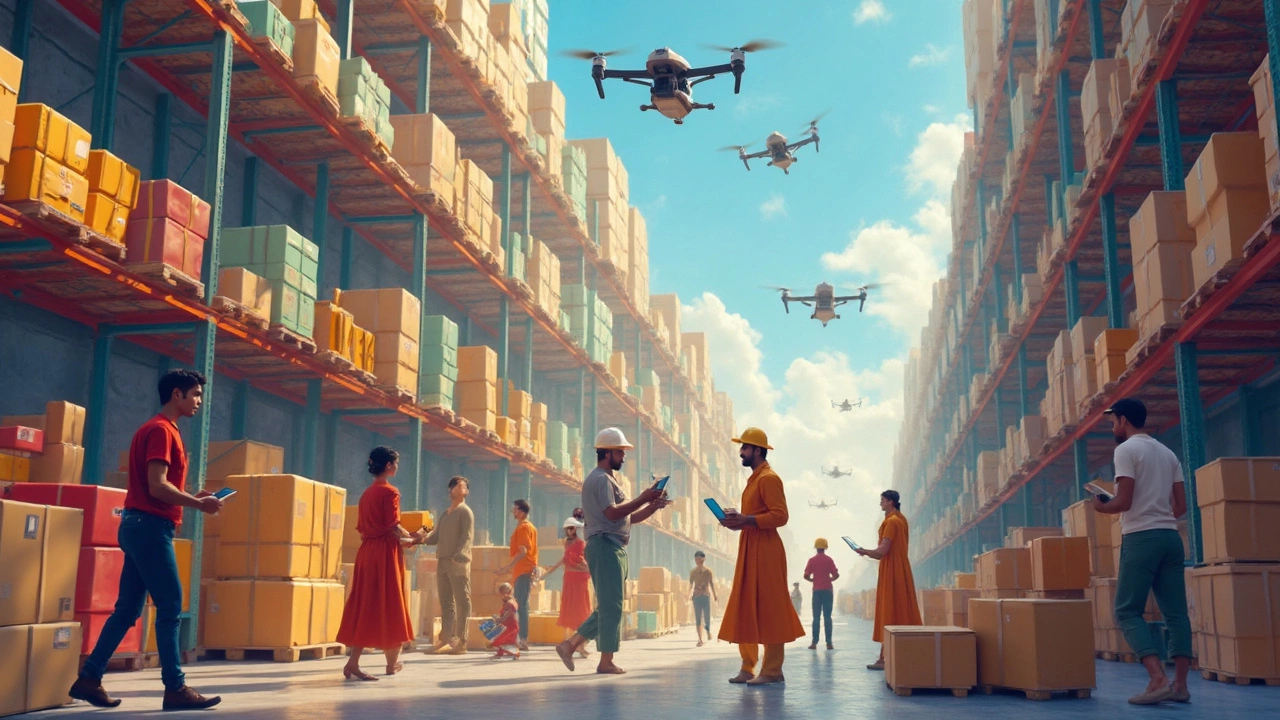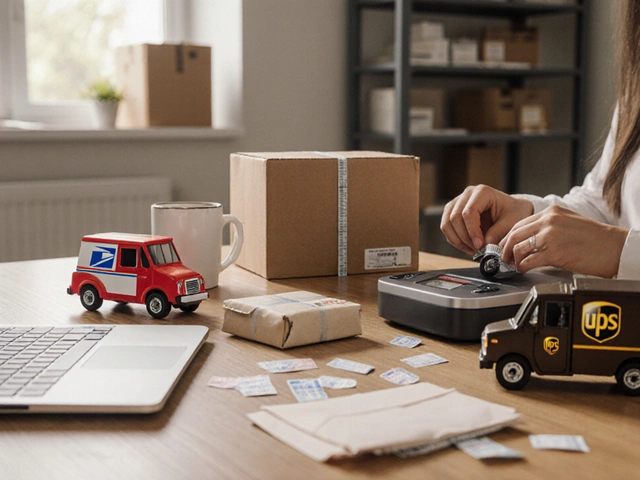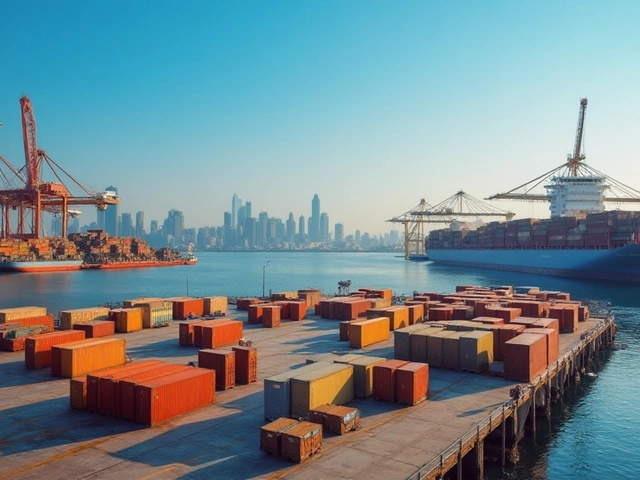Have you ever wondered how all those packages you order online get to your doorstep so quickly? Behind the scenes of e-commerce is a robust logistics system making sure that happens. And you know what? It's not just about moving boxes; it's a strategic game of efficiency and cost management.
Let's kick things off with supply chains. They're like the bloodstream for online businesses. The quicker and smoother they run, the better companies can keep up with demand. Efficient supply chains mean products move faster from manufacturers to consumers, reducing wait times and boosting sales. Ever gotten impatient waiting for a delivery? Yeah, smooth logistics can prevent that.
- Navigating the Supply Chain
- Technology and Efficiency
- Cost-Cutting Strategies
- Customer Satisfaction and Loyalty
Navigating the Supply Chain
Diving into the heart of e-commerce logistics, the supply chain is what keeps everything ticking like clockwork. Think of it as a series of steps that need to be completed for a product to go from a warehouse to your front door. The challenge? Doing it fast and without breaking the bank.
Understanding the Flow
The supply chain starts with manufacturing, moves through warehousing, and ends with delivery. Sounds simple, right? But there's more to it. Each stage is interconnected, and a hiccup in one part can mess up everything. For example, if warehouses are not properly managed, products might not reach the delivery stage on time, causing delays.
E-commerce giants like Amazon have mastered this by using a network of warehouses close to major consumer bases. This cuts down delivery times and fuels their promise of two-day or even same-day delivery.
Technology's Role
Technology is a game-changer here. Advanced software helps companies track inventory in real-time. They can predict demand, manage stock levels better, and, importantly, avoid overstocking or stockouts. This goes a long way in ensuring efficiency and profitability.
- Inventory Management Systems (IMS)
- Automated Warehousing Solutions
- Real-time Tracking Software
These tools support logistics teams in making informed decisions, prepping them to navigate unexpected disruptions swiftly.
Importance of Relationships
Building solid relationships with suppliers and courier services is crucial for a seamless supply chain. Strong partnerships mean better negotiation power for costs and flexible arrangements when unexpected issues arise.
| Stage | Average Time Reduction |
|---|---|
| Manufacturing | 10% |
| Warehousing | 15% |
| Delivery | 20% |
Reducing time at each stage speeds up the overall process, giving businesses a vital edge in competitive e-commerce markets. A streamlined supply chain not only delights customers with speedy deliveries but also boosts the bottom line.
Technology and Efficiency
So, let's talk about how technology is shaking up the logistics game in the e-commerce world. It's kind of like having a superpower, making everything faster and cheaper.
Warehouse Automation
Picture a warehouse buzzing with robots zipping around, picking products with precision. That's what's happening now with warehouse automation. By using automated guided vehicles (AGVs) and robotics, warehouses can process orders faster and with fewer errors. This not only speeds things up but also reduces costs, which means more profits. Cool, right?
Tracking Systems
Remember when you could only guess when a delivery might arrive? Today, logistics uses real-time tracking systems to keep tabs on every package. Customers love it because they know exactly when their order will arrive. For businesses, it's like a digital control tower that keeps everything running smoothly, helping minimize delays and improve efficiency.
Data Analytics
Data is king. In logistics, analyzing customer data and delivery patterns helps companies optimize routes and networks. By doing this, they save on fuel and labor, which again cuts costs significantly. Susan Reid, a supply chain manager at XYZ Corp, says,
"Data-driven decisions have allowed us to cut our logistics expenses by 25% in the last two years."
AI and Machine Learning
Artificial intelligence (AI) and machine learning are stepping in to predict customer demand and manage inventory. This minimizes wastage and stockouts, helping companies keep the right amount of products in stock. In a nutshell, AI is like having a crystal ball for logistics!
Table: Impact of Technology on Logistics
| Technology | Impact |
|---|---|
| Warehouse Automation | 30% faster order processing |
| Real-time Tracking | 20% improvement in customer satisfaction |
| Data Analytics | 25% cost reduction |
| AI Forecasting | 15% inventory optimization |
Embracing these technologies can transform how e-commerce logistics hits financial goals. It's all about making smart investments now that pay off big time down the road.

Cost-Cutting Strategies
Being smart with costs is what keeps logistics as a key player in e-commerce success. Companies are always finding new ways to deliver packages without breaking the bank. One way they do this is by optimizing inventory storage. Instead of renting massive warehouses, businesses explore smaller, strategically located warehouses closer to key customer areas. This reduces storage costs and speeds up delivery, killing two birds with one stone.
Next up, let's talk about the power of bulk. Don’t you love getting a good deal on a bulk purchase? It's a similar idea here. When shipping in bulk, companies can negotiate better rates with carriers. They might not pass the savings directly to customers, but it does help them maintain healthy profit margins. Additionally, using automated packaging machines cuts down on workforce requirements, meaning fewer salaries to pay.
Tech to the Rescue
Technology isn't just about the flashy gadgets; it's a serious cost saver. By implementing advanced route planning systems, delivery routes are optimized to save on fuel and labor. Think of it as a smart GPS, guiding each delivery vehicle to its stops in the most efficient way. Data analytics tools are pretty handy too; they predict demand spikes so companies can adjust inventory orders and avoid costly overstock or last-minute restocks.
Leveraging Sustainable Practices
Finally, going green can save some green. Sustainable practices like electric vehicles or eco-friendly packaging aren't just good for the planet; they actually reduce long-term costs. Electric vehicles, for example, have lower fuel and maintenance costs than traditional trucks. Plus, these practices attract eco-conscious customers, potentially boosting loyalty and sales.
By keeping costs low without skimping on service, logistics outfits can make sure they’re not just a support act but the stars when it comes to profit in the e-commerce world.
Customer Satisfaction and Loyalty
So, what really keeps customers coming back to an e-commerce platform? It's all about that sweet spot between great service and efficient logistics. When packages arrive on time and without hassle, it creates a positive experience that fosters loyalty.
Why is this so crucial? Well, loyal customers tend to spend more over time and are more likely to refer friends and family. It's a win-win. But how do logistics play into this?
Timely Deliveries
First up, timely deliveries. It's kind of a no-brainer, right? When customers receive their orders when they're expecting them—sometimes even sooner—they're more likely to trust the service again. Late deliveries? They can chip away at trust faster than you'd believe.
Transparent Tracking
Today's consumers love staying in the loop. Logistics fuel customer satisfaction by providing real-time tracking. When buyers can watch their packages travel from point A to B, it gives them peace of mind. Transparency is key here; it builds trust.
Personalized Experience
Here's where things get interesting. With data analytics and efficient e-commerce logistics, companies can tailor delivery experiences. Offer faster shipping options, weekend deliveries, or even environmentally friendly packaging. This personalization makes customers feel valued.
Handling Returns Gracefully
No one likes dealing with returns, but they happen. A smart logistics system facilitates smooth return processes. Free returns, simple guidelines, and speedy refunds can turn a potential pain point into an opportunity to impress. A smooth return policy can be more persuasive than any marketing pitch.
Thanks to the ever-evolving world of technology, companies can now utilize automated systems to keep up with consumer demands. According to a recent survey, nearly 75% of shoppers say they prefer shopping from retailers that offer clear delivery and return policies.
Remember, combining technology, supply chain optimization, and a keen eye on customer needs can result in stellar customer satisfaction. And in this competitive landscape, keeping customers happy is what will keep the revenue flowing.





